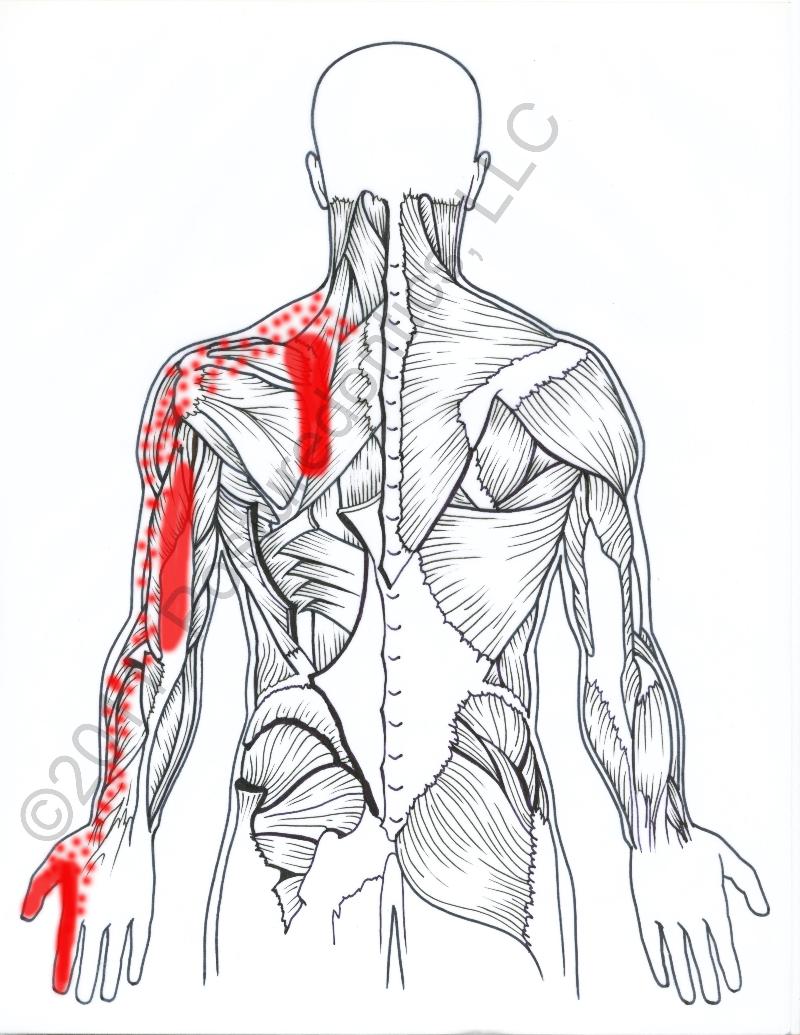 Of these muscles, the scalenes, located deep in the front and sides of the neck, are involved with upper back pain up to 80% of the time. (Gerwin) Scalene TPs are frequently misdiagnosed by healthcare professionals as rhomboid trigger points, since pain is rarely felt in the scalene muscles themselves. Trigger points in these muscles are also a common cause of thoracic outlet syndrome.
Of these muscles, the scalenes, located deep in the front and sides of the neck, are involved with upper back pain up to 80% of the time. (Gerwin) Scalene TPs are frequently misdiagnosed by healthcare professionals as rhomboid trigger points, since pain is rarely felt in the scalene muscles themselves. Trigger points in these muscles are also a common cause of thoracic outlet syndrome.
Scalene trigger point symptoms include:
· Pain in the medial border of the scapula and
interscapular pain
· Aching pain in the chest area (often mistaken for angina pectoris)
· Pain and weakness in the front/back of the arms and thumb side of the hand and index finger
· Dropping of objects
· Moving the arm and neck restlessnessly, to apparently relieve the discomfort
Since the scalenes' primary job is to stabilize your neck against sideways movement, it is easy to see why dental professionals are so vulnerable to developing trigger points in them. Victims of motor vehicle accidents are especially prone to developing severe trigger points in the scalenes, so team members who have been in MVAs should be familiar with all scalene T.P. referral patterns and highly vigilant with preventive strategies.
ERGONOMIC INTERVENTIONS
1. Position the patient properly Team members who persistently lean the head to one side to view the treatment area or infrequently use their mirror will have a difficult time resolving their scalene TPs. Special patient positioning guidelines must be observed to maintain level shoulder posture during all treatment. See video from Positioning for Success DVD. For more video excerpts, please click here.
2. Properly angle the overhead light Contrary to what most dental professionals were taught in school, the overhead light should parallel your line of sight to within 15 degrees. (Rucker) Therefore, it should be positioned slightly behind and to one side of your head. See above video link for light positioning.
3. Armrests Simply taking the weight of the arm off these scalene muscles can help reduce perpetuation of trigger points.
4. Good declination angle Since forward head posture is a contributing factor to scalene trigger points, make sure your scopes have an excellent declination angle (see Dental Ergonomic Loupes Reviews).
5. Chest breathing Shallow, chest breathing, which commonly occurs in the operatory, and can easily cause scalene TPs. Make a concerted effort to use diaphragmatic breathing (stomach goes out when inhaling, not in!) whenever possible.
THERAPIES
The scalene muscle that refers most strongly to the upper back is the anterior scalene, which should be a primary focus of therapy.
Stretching It is imperative to stretch your scalenes frequently (up to 4-5 times per day) if you are going to resolve the trigger points. It is most effective to anchor one hand under the seat of a chair and use the other to increase the stretch (see picture, left). To target the anterior scalene, bring ear toward shoulder, and then tilt the head slightly backward and look up and toward the side being stretched. DOWNLOAD A CHAIRSIDE STRETCHING CHART
Moist heat The scalene muscles are sensitive to cold, so a warm, moist heat (NOT hot!) can be applied over the scalene for 10 minutes or so before stretching.
Therapy for scalene trigger points The scalenes are located deep in your neck and can be difficult to locate. It is best to have a skilled therapist treat these manually or with a spray & stretch technique. Look for a physical therapist who has NAIOMT training (see www.naiomt.com) or is a certified neuromuscular therapist (see www.iahp.com).
Massage your own scalene trigger points It can be tricky to locate your scalene trigger points-you obviously don't want to stick a Backnobber tool in your throat! You must have excellent knowledge of anatomy, as there are vital neurological and vascular structures in close proximity to the scalenes. Clair Davies offers instruction and diagrams for self-treating your own scalene trigger points in The Trigger Point Therapy Workbook. An excerpt follows, "The scalenes cling closely to the neck....to massage the anterior scalene, you have to get your fingers between the neck vertebrae and SCM muscle. To do this, first grip the (left) sternocleidomastoid between your (right) fingers and thumb as if you were going to massage it. Then let go with your thumb, and with your fingers, pull the entire SCM toward the windpipe.....In this position, you can mash the anterior scalene against the vertebral column with the tips of your fingers."
Be sure to reference Davies' book for the entire technique, precautions and treatment of middle and posterior scalene.